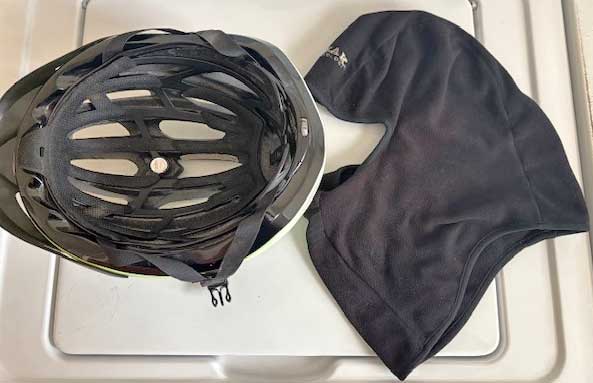Bicycle Helmets for Winter
Summary: Winter commuting or riding can usually be done in your normal helmet, but you will probably have to add at least some ear protection. Face protection adds to comfort when the temperature gets well below freezing. Keeping the rest of your body warm helps, too.
You are preparing for winter commuting or riding, and want the best helmet for cold weather. What to buy?
Adapting your helmet
Most riders start with their normal helmet, and adapt it for winter use by adding something
underneath for warmth. Covering the ears is the most important first step as temperatures begin to fall. Normal active riding generates a lot of heat, and the rest of the head can stay warm with only the thinnest covering, but the ears are out in the slipstream and will be uncomfortable or even frostbitten in very cold weather.
An ear band is the place to start for most riders, since cold affects the ears unless they are held against the head and sheltered from
the wind. A few helmets even come with detachable earmuffs. Those do not affect the helmet's fit, but a thin earband does
not interfere either. Adding an earband is adequate for winter weather in moderate climates. A thicker earband can change the
fit of the helmet unless it is one of the thinner lycra or fleece types. Some riders compensate for that by wearing a sweatband in
summer that is the same thickness as the earband. The sweatband can be pulled down to partially cover the ears when the
temperature is in the range that requires some ear cover but not the full warmth of the earband.
As temperatures drop the earband is not enough. At some point a cap to cover the whole head and ears is better. And at
even lower temperatures a full balaclava head and neck cover may be required. The balaclava design usually has a
rounded facial opening and extends down to cover the neck, a big improvement in comfort. Normally just a thin layer
will keep your head quite warm, and that adds to the warmth of the rest of your body by limiting the heat loss from the
head. Silk, fleece or thin cloth balaclavas cover everything including the lower face, and are so thin that they do not
affect the fit of the helmet.

Another strategy is to block the helmet vents with pieces of soft foam. That works for some, but others end the ride with a sweaty head due to lack of ventilation.
A winter helmet?
If you are considering a winter helmet, there are choices. The downhill mountain bike racing helmet models cover the ears and offer great coverage and good impact protection. Many manufacturers have them, including Bell, Giro, Specialized, Trek, Louis Garneau and many more. (Check our writeup on current helmets for more, with a search for "downhill.") The best meet the ASTM F1952 downhill mountain bike racing standard. They can be heavy and confining, and most urban riders don't find them necessary, but they certainly do provide good impact protection. They might be good for very short rides where you don't want to mess with putting on and taking off lots of accessories. They probably will fog your glasses or goggles at traffic lights, but so will the other arrangements at times. The biggest concern in urban riding would be for peripheral vision and hearing, neither of which is important for downhill bicycle racers but both of which are needed for urban cycling.
Although we always recommend bicycle-specific helmets for cycling, the best ski helmets are usually warm and meet an ASTM or Snell Memorial Foundation ski helmet standard that is very similar in impact protection to a bicycle helmet. But there is no law in the US that says a ski helmet has to meet any standard at all. Some meet only the much weaker EC (European) standard and should never be worn for bicycling. Be sure to check the sticker inside the ski helmet carefully for a statement that it meets ASTM F2040 or the Snell Foundation standard. You are much better off in a helmet designed and certified for bicycling.
If you are wondering how well your helmet will perform in cold weather, we have a page up on cold weather helmet performance with the specific temperatures called out in helmet standards for cold sample testing.
Keeping Everything Warm
Beyond your head, feet and hands are normally the limiting factor in how cold a ride you can stand. Keeping your body and head warm sends warmer blood to the extremities and helps keep feet and hands warm. Covering neck, wrists and ankles well prevents blood in major arteries from cooling in the airflow as you ride. Chemical handwarmer packets can make a big difference in gloves, but the best warmth is from the newer and more expensive battery-powered gloves or mittens.
Avoiding falls
Since you should anticipate falls on ice and snow, you might consider ways to minimize falling to be at least as important as the helmet you have on when you do go down. A tricycle or quad is an expensive but effective way of reducing falls. Studs or mountain bike tires help somewhat in snow, but don't do much for you when the ruts are icy and you can't make the small turning movements that balance a bicycle. (Forward traction is seldom the issue unless the snow is really deep.) A search will turn up lots more advice for winter riding from riders in Canada and other cold places.
Riding in the Dark
Winter helmets are used on the shortest days, and often become night-time helmets. We have a page on bicycle lighting, and another page on adding reflectivity to your helmet. They might be good reading.
Back to the top
Back to the Home Page